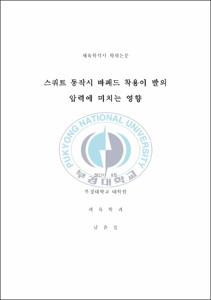스쿼트 동작시 바패드 착용이 발의 압력에 미치는 영향
- Abstract
- Abstract
This study targets 10 male students in their 20s of Department of Physical Education of P University located in B City. Members have been selected out of those who have had irregular weight training experiences including squat for 1 year without any injuries.
This study is purposed to propose indices in order to achieve goals such as preventing one-sided movement of balance, preventing injuries to joints of legs, improving muscular strength of legs, and maximizing sporting achievement with the use of a bar pad for athletes as well as nonathletes. In terms of methodology, this study has compared foot pressure distribution and foot pressure ratio during full-squat and half-squat exercise.
As a result of analysis on impact of full-squat and half-squat exercise on foot pressure distribution and foot pressure ratio with a bar pad and without a bar pad, conclusions have been obtained as shown below.
1. After analyzing the distinction of foot pressure distribution between left and right feet of subjects during full-squat exercise with and without a bar pad, it has been noticed that the distinction of foot pressure between left and right feet was 0.04(±0.04)kgf/cm² without a bar pad and 0.01(±0.01)kgf/cm² with a bar pad, showing significant decline of the distinction of both feet pressure when using a bar pad. Also, it exhibited significant difference(p< .001).
2. After analyzing the distinction of foot pressure distribution between left and right feet of subjects during half-squat exercise with and without a bar pad, it has been noticed that the distinction of foot pressure between left and right feet was 0.04(±0.03)kgf/cm² without a bar pad and 0.01(±0.02)kgf/cm² with a bar pad, showing significant drop of the distinction of both feet pressure when using a bar pad. Also, it exhibited significant difference(p< .001).
3. After analyzing foot pressure ratio of front feet of subjects during full-squat exercise without and with a bar pad, it was found out that front feet pressure ratio of left foot was 41.11(±10.88)% without a bar pad, and 44.27(±11.42)% with a bar pad, showing no significant difference. Also there shows that front feet pressure ratio of right foot was 41.89(±12.09)% without a bar pad, and 47.65(±12.54)% with a bar pad, showing no significant difference.
4. After analyzing foot pressure ratio of back feet of subjects during full-squat exercise without and with a bar pad, it was found out that back feet pressure ratio of left foot was 58.89(±10.88)% without a bar pad, and 55.74(±11.42)% with a bar pad, showing no significant difference. Also there shows that back feet pressure ratio of right foot was 58.11(±12.07)% without a bar pad, and 52.35(±12.55)% with a bar pad, showing no significant difference.
5. After analyzing foot pressure ratio of front feet of subjects during half-squat exercise without and with a bar pad, it was found out that front feet pressure ratio of left foot was 32.04(±7.36)% without a bar pad, and 35.68(±11.74)% with a bar pad, showing no significant difference. Also there shows that front feet pressure ratio of right foot was 33.31(±8.32)% without a bar pad, and 38.74(±12.82)% with a bar pad, showing no significant difference.
6. After analyzing foot pressure ratio of back feet of subjects during half-squat exercise without and with a bar pad, it was found out that back feet pressure ratio of left foot was 67.96(±7.36)% without a bar pad, and 64.32(±11.74)% with a bar pad, showing no significant difference. Also there shows that back feet pressure ratio of right foot was 66.69(±8.32)% without a bar pad, and 61.27(±12.82)% with a bar pad, showing no significant difference.
- Issued Date
- 2013
- Awarded Date
- 2013. 8
- Type
- Dissertation
- Publisher
- 부경대학교
- Affiliation
- 대학원
- Department
- 대학원 체육학과
- Advisor
- 김용재
- Table Of Contents
- Ⅰ. 서 론 1
1. 연구의 필요성 1
2. 연구의 목적 4
3. 연구의 문제 4
4. 연구의 제한점 4
5. 용어의 정의 5
Ⅱ. 이론적 배경 7
1. 웨이트 트레이닝의 특성 7
2. 스쿼트와 바패드 8
3. 스쿼트와 발의 압력 10
Ⅲ. 연구방법 13
1. 연구대상 13
2. 측정기구 14
3. 측정항목 15
4. 측정방법 15
5. 실험절차 18
6. 통계처리방법 19
Ⅳ. 연구 결과 20
1. 풀스쿼트 시 바패드 착용유무에 따른 양발의 압력분포 20
2. 하프스쿼트 시 바패드 착용유무에 따른 양발의 압력분포 22
3. 풀스쿼트 시 바패드 착용유무에 따른 양발의 압력비율 23
4. 하프스쿼트 시 바패드 착용유무에 따른 양발의 압력비율 25
Ⅴ. 논의 27
1. 풀스쿼트 시 바패드 착용유무에 따른 양발의 압력분포 28
2. 하프스쿼트 시 바패드 착용유무에 따른 양발의 압력분포 29
3. 풀스쿼트 시 바패드 착용유무에 따른 양발의 압력비율 30
4. 하프스쿼트 시 바패드 착용유무에 따른 양발의 압력비율 31
Ⅵ. 결론 32
참고문헌 34
- Degree
- Master
- Files in This Item:
-
-
Download
 스쿼트 동작시 바패드 착용이 발의 압력에 미치는 영향.pdf
기타 데이터 / 3.13 MB / Adobe PDF
스쿼트 동작시 바패드 착용이 발의 압력에 미치는 영향.pdf
기타 데이터 / 3.13 MB / Adobe PDF
-
Items in Repository are protected by copyright, with all rights reserved, unless otherwise indicated.